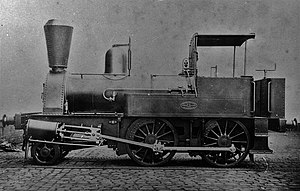The South Australian Railways G Class locomotives first appeared on the South Australian Railways in 1869 after being purchased from Beyer, Peacock and Company. More locomotives were purchased and in service by 1880, and again in 1886. The G class was extinct by 1923.[1]
| South Australian Railways G Class | |||||||||||||||||||||||||||||||||||||||||||
|---|---|---|---|---|---|---|---|---|---|---|---|---|---|---|---|---|---|---|---|---|---|---|---|---|---|---|---|---|---|---|---|---|---|---|---|---|---|---|---|---|---|---|---|
 South Australian Railways G Class Locomotive | |||||||||||||||||||||||||||||||||||||||||||
| |||||||||||||||||||||||||||||||||||||||||||
| |||||||||||||||||||||||||||||||||||||||||||
| |||||||||||||||||||||||||||||||||||||||||||
| |||||||||||||||||||||||||||||||||||||||||||
History
editOnly five of the G class locomotives were purchased new by the South Australian Railways from Beyer, Peacock and Company. The rest of the class were acquired upon the takeover of the Glenelg and Grange railway lines from private operators. On 2 August 1873, the Adelaide, Glenelg and Suburban Railway Company opened a line between Adelaide and Glenelg via King William Street and South Terrace, Adelaide. This is the route currently used by trams on the Glenelg tram line. On 25 May 1880, the Holdfast Bay railway line was officially opened and a line from the Adelaide railway station, North Terrace to Glenelg through Richmond and Plyptom. These two lines were eventually amalgamated in 1881 and formed the Glenelg Railway Company. The Glenelg Railway Company in turn passed over the Government control on 15 December 1899. The Grange Railway Company built and operated a line between Woodville and Grange in 1882, which was then acquired by the South Australian Railways on 1 January 1893.
G class locomotives No. 23 and No. 24 were the first of two locomotives of the class imported to work over the newly opened Roseworthy-Tarlee section of the Northern Railway in 1869. No. 23 was the first of many locomotives purchased from Beyer Peacock by the SAR. No. 23 and No. 24 were later employed to work on the Strathalbyn to Victor Harbor railway line. The remaining three G class locomotives (No. 99, 100 and 101) replaced the Belgian Steam Railcar on the Strathalbyn to Milang and to Victor Harbor railway line.[2][3]
References
edit- ^ Drymalik, Chris. "Broad Gauge G-class 2-4-0 tank locomotives". Chris's Commonwealth Railways Information (ComRails). Retrieved 30 July 2019.
- ^ FLUCK, R. E.; SAMPSON, R.; BIRD, K. J. (1986). STEAM LOCOMOTIVES AND RAILCARS OF THE SOUTH AUSTRALIAN RAILWAYS. South Australia: Mile End Railway Museum (S.A.) Inc. pp. 47–50. ISBN 0959-5073-37.
- ^ Drymalik, Chris. "Broad Gauge G-class 2-4-0 tank locomotives". Chris's Commonwealth Railways Information (ComRails). Retrieved 30 July 2019.